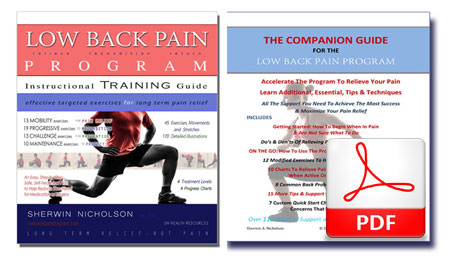10 Exercises that Relieve Lower Back & Hip Pain
Sherwin Nicholson Hons.BSc. | SN Health Resources | Updated May 7, 2020
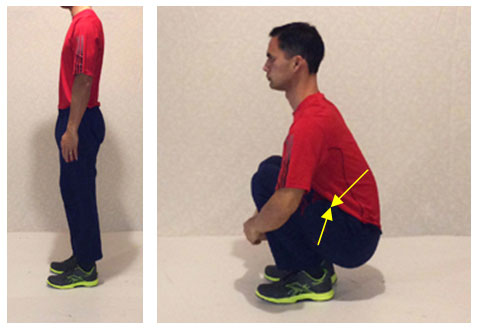
Note: Slide/scroll down to get to all of the essential exercises
Follow these Exercises for Relief
You can do them in under 1 minute each to help relieve discomfort. Select the images below to start.
Do you find the internet, bookstores and treatment providers suggest an almost unlimited but somewhat confusing number of stretches and poses for relief? Are you confused about the choices you should make?
Where to begin? What to do? How to do it? Why? For how long?
This site is here to help clear up the confusion and to give you proven movements that your body needs.
The best approach is with structured and targeted movements. Not workouts at the gym but simple and quick movements and stretches. They are necessary for restoring and protecting both your back, leg and hip mobility.
Below are 10 important exercises you should be doing every day to relieve back pain
What are the benefits:
- They provide strength, flexibility and relief for those with back and hip pain due to muscular issues.
- They can be done anywhere and anytime.
- They use no equipment.
- They help to recondition neglected muscle groups and function to prevent injury.
If you have issues, please consult a physician before performing any physical movements provided on this site.
Please note: If you have problems with very tight and stiff muscles and joints, you will initially find the full movements difficult to perform. Although this is to be expected, as you progress, you will find it easier as your strength and flexibility improves.
How much time do spend on them?
Spend anywhere from a few seconds and a few reps at first. But be sure to increase your time and rep number. Don’t push yourself too much or you’ll be doing more harm than good.
Each one will require a few days to a few weeks to create the improvements needed and to master.
What can I expect for my recovery time?
Because your muscles and joints need to adjust with your changes incrementally, healing and rebuilding is a slow process. It takes time for the weaker areas of your body to respond and support you.
Any treatment plan worth doing will require time, especially in circumstances where injuries have occurred. Many have proven to help provide real relief within the first week of practice.
The best approach is with structured and targeted movements. Not gym ‘workouts’ but simple and quick movements and stretches. They’ll protect your back, leg and hip mobility.
Here are the top 10 you can do at home:
The first thing you’ll notice is that some of these movements are fairly hard to do. That’s the very point.
They are really a test to show you how much you need to use them to regain your lost strength and flexibility. As it becomes easier for you to do them, the better you’ll feel.
Important: After trying these 10, be sure to go the download page for the full course. This course reverses your discomfort by teaching you step by step, in order, how to correct your problems long term.
Each link below explains the movements in full. The eBook which contains a complete set of exercises to address your discomfort in depth can be download and used anytime, anywhere.
To go directly to each action, click on each one.
1)
Seated Lunge – Helps those with difficulty sitting for long periods.
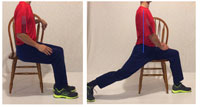
Helps to prevent you from tightening up as you sit at work or at home. It will also relieve this tension once it happens. You should be lunging in your seat as often as possible.
2)
Deep Squat Rest – For those that have trouble standing without pain.

This is a tough one to master but will make a huge difference in relieving your tension and pain. Once you can do it, you’ll feel a lot better for the long run. Make Deep Squatting your first need in the morning and just before you go to bed.
3)
Standing Hip Shift – For pain in the morning when you wake as well as through the night.
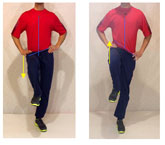
Hip shifting is a must to release hip pain. You’ll be surprised how much you need to do it. The flexibility and strength that you gain from this simple movement will have dramatic benefits for you.
4)
Seated Twist – If you have chronic spasms.

This simple twist will not only help your back spasms but will also help to release both your upper and lower back soreness that you may have found very tough to overcome. Back spasm be gone!
5)
Seated Hamstring Stretch – The right way to stretch your hamstrings.

Don’t lean over to touch your toes! You’ll only injure your spine. Hamstrings should be stretched this way. It’s a much more effective stretch and protects your spine at all times.
6)
Standing Abdominal – Help correct your pelvic tilt. For pain when are standing.
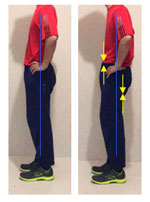
If you hurt when you stand, especially just above your buttocks on your spine, then you should master this simple movement. It’s easy and you can protect yourself virtually anytime you have to remain standing.
7)
Reverse Lunge – Weak glutes always lead to back problems and tight hips.
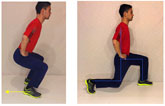
This is the right way to lower yourself. No more leaning or bending forward. If you are hurting, then you need to reverse lunge instead of leaning down. It makes all the difference.
8)
Seated Leg to Chest – When you have tender and tight glutes (buttocks).
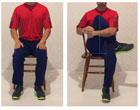
This is a very important stretch if you’re having pins and needles and/or leg cramps. This is the stretch to master and you will reverse your pain dramatically!
9)
Seated Leg Cross – For sore and aching hip muscles. Loosens tight back muscles.

This is a tough one but once you get the hang of it, your hips will thank you. Take your time and go slowly. Your hip flexibility is key to pain relief.
10)
Lying Twist – For your tight and weak, lower back.

Release your tension and stiffness while literally resting. Move slowly and feel the difference in the released tension.
You will help relieve pain and also assist the spine, because hip issues also affect lumbar stability.
By treating the hip, you will also relieve your back. When hip & joint muscles lose flexibility and mobility, the lower back must overcompensate. In time, it becomes strained and fatigued.
Get more help here:
- How to Use the eBook (Where to begin? How many per day? How long?)
- What are the exercises that I will be doing and what is in the book?
- What have other customers thought about the book?
- Where can I order my copy?
- Where can I get your Companion Guide?
Take these guides wherever you go to feel pain relief again
You will learn hundreds of easy & safe solutions to help you right away

